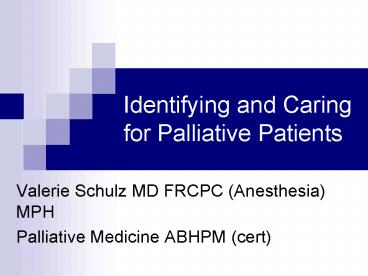Identifying and Caring for Palliative Patients - PowerPoint PPT Presentation
1 / 26
Title:
Identifying and Caring for Palliative Patients
Description:
Identifying patients at risk of dying. Pre-active dying ... T-Res requirements for End of Life Care ... syncope, and recent CVA. Frequent ER visits for symptoms ... – PowerPoint PPT presentation
Number of Views:269
Avg rating:3.0/5.0
Title: Identifying and Caring for Palliative Patients
1
Identifying and Caring for Palliative Patients
- Valerie Schulz MD FRCPC (Anesthesia) MPH
- Palliative Medicine ABHPM (cert)
2
Overview
- Identifying patients at risk of dying
- Pre-active dying
- Would you be surprised if this patient died in
the next 6 months? - Actively dying
- Finding management strategies
- T-Res requirements for End of Life Care
3
Would you be surprised if this patient died in
the next 6 months?
- 6 cases will be presented
4
Pre-Active Dying
- Patient presentation unique to the clinical
situation cancer, organ or system failure
5
84 y/o in hospital with this heart disease?
- CHF symptoms at rest
- EF lt 20
- New dysrhythmia
- syncope, and recent CVA
- Frequent ER visits for symptoms
6
68 y/o smoker with this pulmonary disease?
- Dyspnea at rest
- Signs or symptoms of right heart failure
- O2 sat lt 88 on oxygen
- pCO2 gt50
- FEV1 lt 25 predicted
- Unintentional weight loss
7
88 y/o with these symptoms of dementia?
- Inability to walk
- Incontinence
- Fewer than six intelligible words
- Albumin lt 25 or decreased po intake
- Frequent ER visits
8
54 y/o ETOH abuser with this liver disease?
- INRgt5 seconds
- Albumin lt25, Na ,130
- Refractory ascites
- Spontaneous Bacterial Peritonitis
- Jaundice
- Malnutrition and muscle wasting
9
64 y/o with irreversible multiple myeloma
developing renal disease?
- Not a candidate for dialysis
- Creatinine clearance lt 15 ml/min
- Serum creatinine gt600
10
92 y/o in ER with Failure to Thrive (FTT)?
- Frequent ER visits
- Albumin lt25
- Unintentional weight loss
- Decubitus ulcers
- Homebound/bedconfined
11
University of Alabama - Dr. Amos Bailey et.al.
- Identifying the Actively Dying Patient
- screen patients at highest risk of end-of-life
symptoms and who may be actively dying
12
What are the Indicators that Patients are at
High Risk of Entering the Actively Dying Process?
13
Indicators of Patients at High Risk of Entering
the Actively Dying Process
- Pre-existing DNAR order
- LOS in hospital gt 7 days
- Bed confinement
- Semi-comatose state
- Minimal oral intake (receiving IV fluids or tube
feeding) - Inability or difficulty with taking oral medicine
14
Indicators of Patients at High Risk of Entering
the Actively Dying Process
- Decline in functional status with no reversible
cause - Receiving optimum disease modifying therapy (e.g.
patient with COPD declining despite aggressive
treatment) - failure to improve by 2-3 days post admission
- Frequent Emergency Room visits or
hospitalizations over the last 6 months - primary diagnosis of cancer or dementia
15
Patients at Risk of Dying
- If one or more of the indicators are present
- Review patient status for symptom burden
- Discuss illness severity with patient and/or
family - determine goals of care
- Document advanced directives
16
How do Actively Dying Patients Appear?
17
Actively Dying Patient Screen
- Audible retained respiratory secretions
- increased RR (gt18-20/minute)
- sustained tachycardia at rest (gt100 per minute)
- mottling and cyanosis of extremities
- decreasing level of consciousness
- decreasing pulses
18
Where can you find the management strategies for
dying patients?
19
Just in time learning!
20
Resources to assist with assessing and managing
dying patients
- University of Alabama at Birmingham
- The Palliative Response Manual
- http//www.palliative.uab.edu/
- Links to End of Life Care websites
- http//www2.edc.org/lastacts/links.asp
- Summarized in Clerkship handbooks
- Consult Palliative Care
21
T- Res, clerkship requirement
- Be present as a part of the health care team for
any 2 End of Life patients - Identifying a patient at risk of dying
- Transitioning care from acute care to End of Life
Care - Care for a dying patient/family
- Complete to EOL worksheet to give to your senior
resident during your exit interview - Check your Palliative Patient on T-Res
22
Palliative Patient Checklist
- To be designed (including info on the next 2
slides in the checklist)
23
Be clear about
- Desired Location of death consider where the
patient should be for care while dying - Diagnosis record what the patient is dying from
including primary disease and all co-morbidites - Condition record patient is dying
- Patient/family preferences goals of care, code
status
24
The Actively Dying Patient
- Communicate with medical team, patient and family
regarding care preferences - Patient and family will need support from an
interdisciplinary team
25
Treat Dying as a phase of life
- Avoid avoidance of the
- Situation
- Patient
- Family
- Be present as a caring person
26
Dying people die despite acute care- we can
strive for a dignified death

